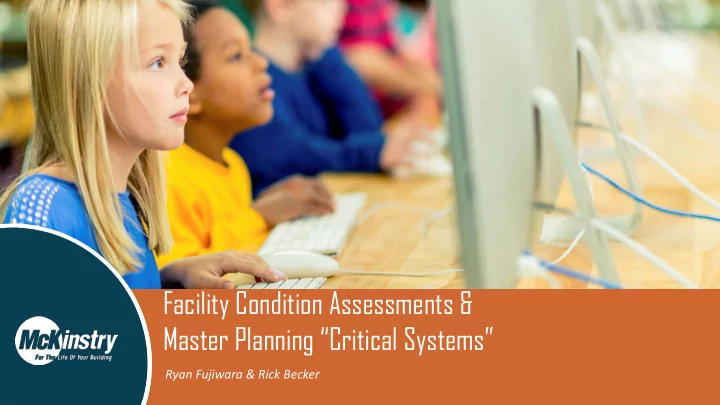

Facility Condition Assessments & Master Planning “Critical Systems” Ryan Fujiwara & Rick Becker
Pursuing The Right Outcomes McKinstry’s Help We Are The right level of data collected, K-12 Experts interpreted, & visualized to help the district take action. Ongoing consulting of best practices and Experienced data integrators. next steps. Accurate, construction-grade Engineers, builders and repairers. cost estimates and identified incentives.
McKinstry and North Santiam School District Partnership Working together as North Santiam's partner leveraging State funding, developing actionable plan, prioritizing projects and balancing fiscal (bond/operations) responsibilities to ensure school facilities are aligned to support district's educational outcomes Facility Condition Assessment & Analysis Master Planning “Critical Systems” Grant Funding Secured • Technical Assistance Program (TAP) Grant Awarded $45K Energy Projects Funding Available • Oregon Department of Energy (ODOE) Schools Program (SB1149 program): $440,000 (know how to coordinate and implement with ODOE to maximize use) Grant and Incentive Funding Opportunities (application and coordination) • Oregon Bond Matching Program (OSCIM) $4 Million confirmed • Energy Trust of Oregon’s incentive programs (ETO) Public Utility $$$$ (currently coordinating for North Santiam SD) Operational Utility Saving Efficiencies - Currently Assessing $$$$
Master Planning Facilities Management – Best Practices Why do we have to pay for this? Doesn’t the state fund education? • The State of Oregon is responsible for funding education. However, this does not include providing funding for the school facilities construction or equipment life cycle replacements. That responsibility falls to the communities served by the school districts. • Local (Bond) funding of school construction projects ensures that communities maintain a strong voice in how their educational facilities are managed and operated. What do Bonds pay for? • Must be used for capital expenditures: • • Land purchases Initial equipment purchase • New building construction • Critical Systems upgrades • • Remodeling of existing facilities Implementing technology systems • Additions to buildings
Master Planning - Capital Bond Priorities Finding the Right Balance Special Projects Growth and Remodels Critical Systems Projects $$$$ Projects $$$$ Projects $$$$ SUB TOTALS SUB TOTALS SUB TOTALS Bond Total $ (Board Parameters)
Master Planning Facilities Management – Best Practices Protecting the Public’s Investment Total Cost of Ownership A systematic approach to ensure performance accountability; promote student health and safety by maintaining and operating building systems to their design capacity; maintain an encouraging learning environment; and extend building life, thus minimizing future capital needs • Linking of capital (Bond) facility and maintenance/operations (General Fund) investments over expected facility/equipment lifecycles (10, 20 & 30+ years) I nitial/ Replacem ent Cost + Maintenance + Operations = Total Cost of Ow nership General Fund $ Capital $$
Master Planning Facilities Management – Best Practices Finding the "Right Balance" between Maintenance/Operations WITH New Construction AND Critical Systems Replacement AND Special Projects 1. Maintenance/Operations: Scheduled, Preventative and Unscheduled Projects Appropriate Funding (Annually) to support Maintenance & Operations (building request or projects) Potential impacts or risk of poor facility maintenance management • Educational mission (warm, safe and dry learning environments) • Indoor Air Quality (health, comfort, and lighted learning environmental) • Equitable facilities (educational access to learning environments and community access to public spaces) • Negative perceptions (students, staff, parents and community)
Master Planning Facilities Management – Best Practices 2. Critical Systems Replacement (Facility or Equipment replacement) Funded on a regular Bond/Levy Cycle to replace/upgrade building and equipment life-cycles • Last district bond passed in 2012 for $25M Potential impacts and risk of poor critical systems replacement cycles • Additional cost/impacts general "operating" fund budget (staffing, equipment replacements, materials or contractors) • Educational mission (warm, safe and dry learning environments) • Indoor Air Quality (health, comfort, and lighted learning environmental) • Inequitable facilities (educational access to learning opportunities/environments and community access to public spaces) • Negative perceptions (stakeholders)
Master Planning Facilities Management – Best Practices 3. New Construction or New in Lieu Projects q Funded thru Bond Cycles for New or New in Lieu of construction projects (Schools, Additions or Tenant Improvements) • Last district bond passed in 2012 for $25M • Three-quarters of all public infrastructure projects in the United States are built by states and localities, and tax-exempt bonds are the primary financing tool utilized to satisfy these infrastructure needs 4. Special Projects (Capital Bond or General Fund) • Examples: Security, Field replacements, Swimming Pools,
Facilities Condition Assessment (FCA) Uncovers immediate needs • From equipment with imminent failure to small maintenance issues Provides direction for operational activities • Establish baseline and catalogue institutional knowledge Informs Master Planning (Capital Bonds and Operations) • Avoid failure and identify investment priorities Wholistic view • Helps meld emotions around schools with data (non-emotional) to make the best decisions
Facility Conditions Assessment (FCA) How is Data Collected? 1. Building and Equipment “Boots on the ground” Assessments (every school, every door, etc.,) 2. Extensive observation and recording of building systems * Heating, Ventilation, Air Condition (HVAC) * Building Controls (BAS) * Mechanical, Electrical & Plumbing (MEP) * Equipment * Lighting * Windows * Fire & Life Safety Equipment * Site Development * Interiors (Flooring, Finishes, Furniture) * Roofs * Technology (server, MDF, IDF rooms) * Outdoor Educational Space (Fields and Playgrounds) 3. High level of detail * 2018 value of assets: $66.2M (30 years) * 14 buildings including outdoor spaces * Total Square Feet: 400,000 * Assets recorded: 765 * Photographs captured: 6,000 * Distinct data points recorded: 13,457
Recommend
More recommend